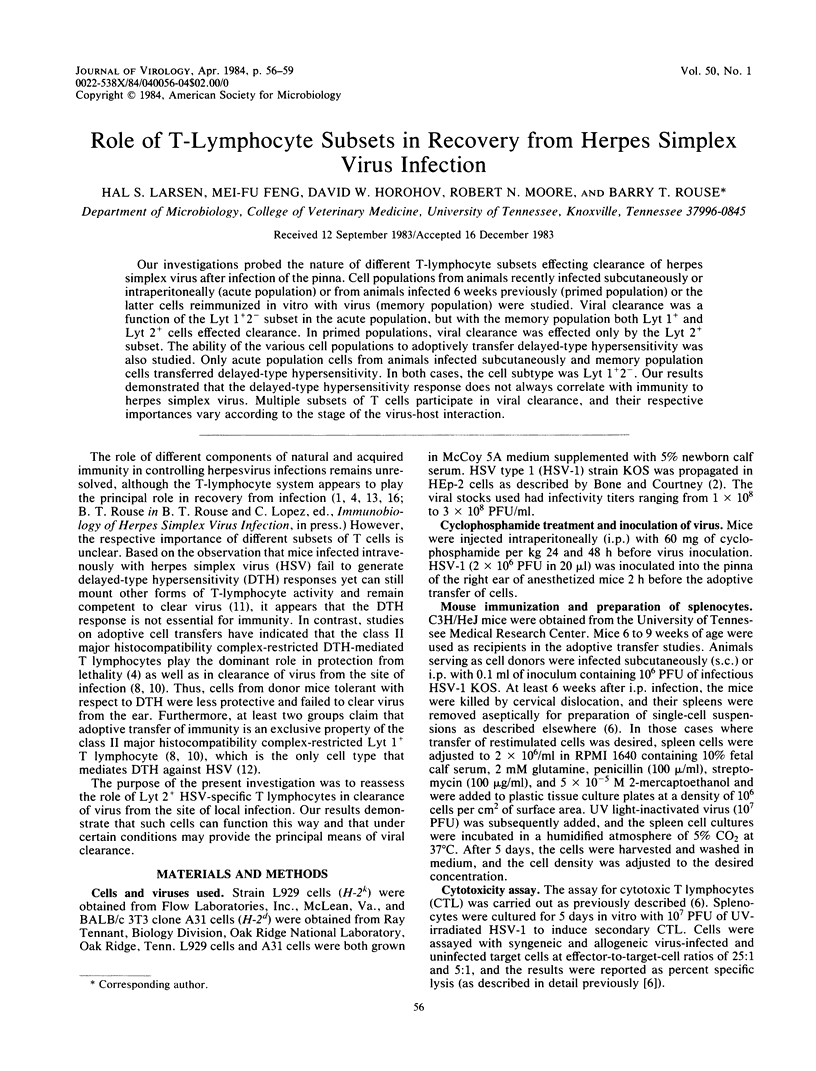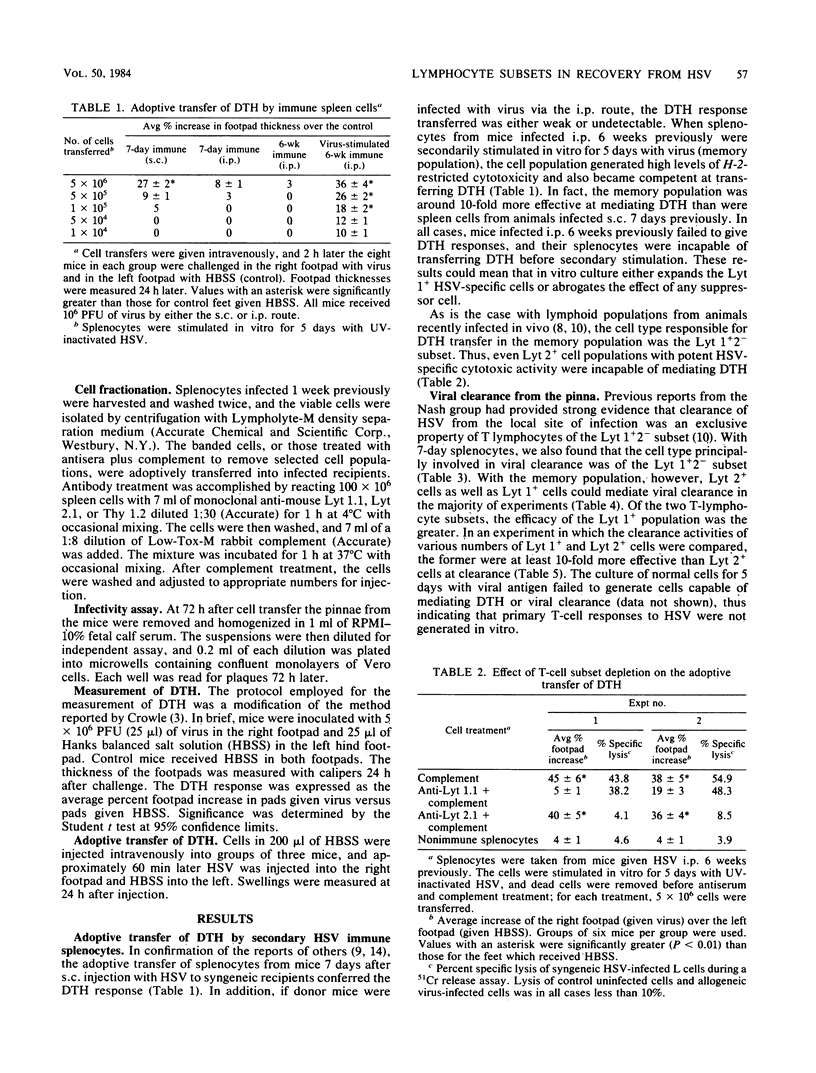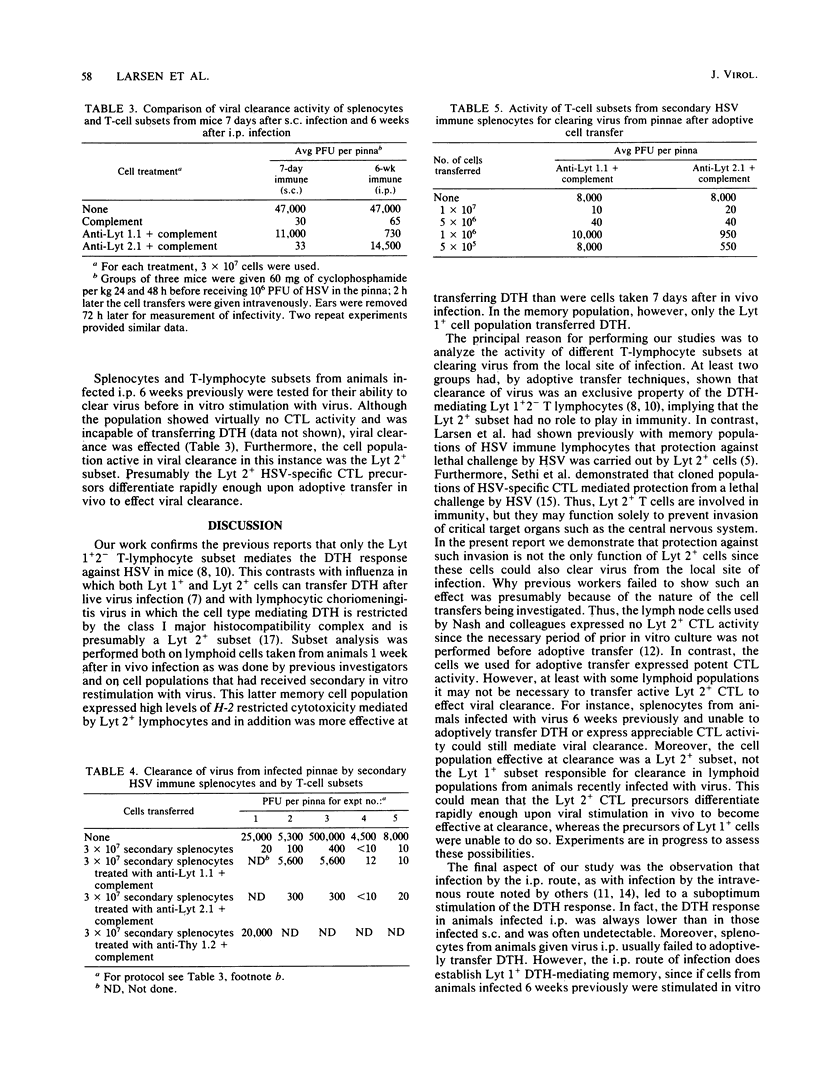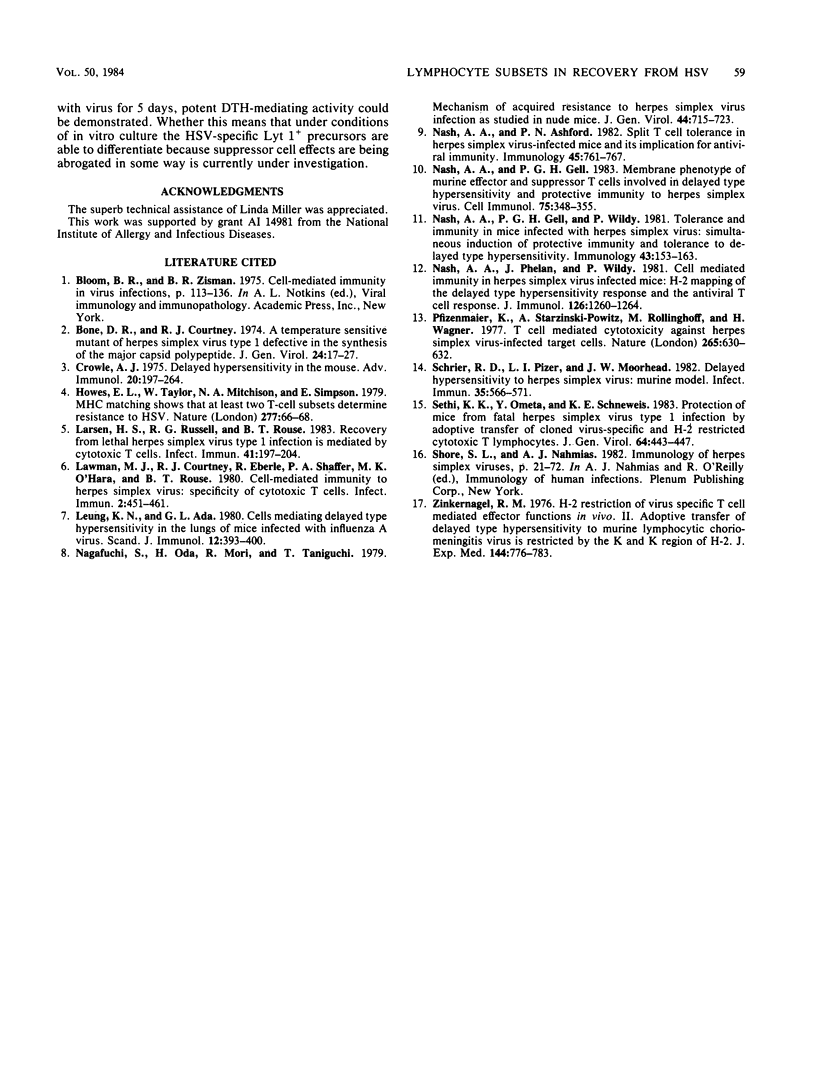Abstract
Our investigations probed the nature of different T-lymphocyte subsets effecting clearance of herpes simplex virus after infection of the pinna. Cell populations from animals recently infected subcutaneously or intraperitoneally (acute population) or from animals infected 6 weeks previously (primed population) or the latter cells reimmunized in vitro with virus (memory population) were studied. Viral clearance was a function of the Lyt 1+2- subset in the acute population, but with the memory population both Lyt 1+ and Lyt 2+ cells affected clearance. In primed populations, viral clearance was effected only by the Lyt 2+ subset. The ability of the various cell populations to adoptively transfer delayed-type hypersensitivity was also studied. Only acute population cells from animals infected subcutaneously and memory population cells transferred delayed-type hypersensitivity. In both cases, the cell subtype was Lyt 1+2-. Our results demonstrated that the delayed-type hypersensitivity response does not always correlate with immunity to herpes simplex virus. Multiple subsets of T cells participate in viral clearance, and their respective importances vary according to the stage of the virus-host interaction.
Full text
PDF



Selected References
These references are in PubMed. This may not be the complete list of references from this article.
- Bone D. R., Courtney R. J. A temperature-sensitive mutant of herpes simplex virus type 1 defective in the synthesis of the major capsid polypeptide. J Gen Virol. 1974 Jul;24(1):17–27. doi: 10.1099/0022-1317-24-1-17. [DOI] [PubMed] [Google Scholar]
- Crowle A. J. Delayed hypersensitivity in the mouse. Adv Immunol. 1975;20:197–264. doi: 10.1016/s0065-2776(08)60209-6. [DOI] [PubMed] [Google Scholar]
- Howes E. L., Taylor W., Mitchison N. A., Simpson E. MHC matching shows that at least two T-cell subsets determine resistance to HSV. Nature. 1979 Jan 4;277(5691):66–68. doi: 10.1038/277067a0. [DOI] [PubMed] [Google Scholar]
- Larsen H. S., Russell R. G., Rouse B. T. Recovery from lethal herpes simplex virus type 1 infection is mediated by cytotoxic T lymphocytes. Infect Immun. 1983 Jul;41(1):197–204. doi: 10.1128/iai.41.1.197-204.1983. [DOI] [PMC free article] [PubMed] [Google Scholar]
- Lawman M. J., Courtney R. J., Eberle R., Schaffer P. A., O'Hara M. K., Rouse B. T. Cell-mediated immunity to herpes simplex virus: specificity of cytotoxic T cells. Infect Immun. 1980 Nov;30(2):451–461. doi: 10.1128/iai.30.2.451-461.1980. [DOI] [PMC free article] [PubMed] [Google Scholar]
- Leung K. N., Ada G. L. Cells mediating delayed-type hypersensitivity in the lungs of mice infected with an influenza A virus. Scand J Immunol. 1980;12(5):393–400. doi: 10.1111/j.1365-3083.1980.tb00083.x. [DOI] [PubMed] [Google Scholar]
- Nagafuchi S., Oda H., Mori R., Taniguchi T. Mechanism of acquired resistance to herpes simplex virus infection as studied in nude mice. J Gen Virol. 1979 Sep;44(3):715–723. doi: 10.1099/0022-1317-44-3-715. [DOI] [PubMed] [Google Scholar]
- Nash A. A., Ashford N. P. Split T-cell tolerance in herpes simplex virus-infected mice and its implication for anti-viral immunity. Immunology. 1982 Apr;45(4):761–767. [PMC free article] [PubMed] [Google Scholar]
- Nash A. A., Gell P. G. Membrane phenotype of murine effector and suppressor T cells involved in delayed hypersensitivity and protective immunity to herpes simplex virus. Cell Immunol. 1983 Feb 1;75(2):348–355. doi: 10.1016/0008-8749(83)90332-5. [DOI] [PubMed] [Google Scholar]
- Nash A. A., Gell P. G., Wildy P. Tolerance and immunity in mice infected with herpes simplex virus: simultaneous induction of protective immunity and tolerance to delayed-type hypersensitivity. Immunology. 1981 May;43(1):153–159. [PMC free article] [PubMed] [Google Scholar]
- Nash A. A., Phelan J., Wildy P. Cell-mediated immunity in herpes simplex virus-infected mice: H-2 mapping of the delayed-type hypersensitivity response and the antiviral T cell response. J Immunol. 1981 Apr;126(4):1260–1262. [PubMed] [Google Scholar]
- Pfizenmaier K., Starzinski-Powitz A., Röllinghoff M., Falks D., Wagner H. T-cell-mediated cytotoxicity against herpes simplex virus-infected target cells. Nature. 1977 Feb 17;265(5595):630–632. doi: 10.1038/265630a0. [DOI] [PubMed] [Google Scholar]
- Schrier R. D., Pizer L. I., Moorhead J. W. Delayed hypersensitivity to herpes simplex virus: murine model. Infect Immun. 1982 Feb;35(2):566–571. doi: 10.1128/iai.35.2.566-571.1982. [DOI] [PMC free article] [PubMed] [Google Scholar]
- Sethi K. K., Omata Y., Schneweis K. E. Protection of mice from fatal herpes simplex virus type 1 infection by adoptive transfer of cloned virus-specific and H-2-restricted cytotoxic T lymphocytes. J Gen Virol. 1983 Feb;64(Pt 2):443–447. doi: 10.1099/0022-1317-64-2-443. [DOI] [PubMed] [Google Scholar]
- Zinkernagel R. M. H-2 restriction of virus-specific T-cell-mediated effector functions in vivo. II. Adoptive transfer of delayed-type hypersensitivity to murine lymphocytic choriomeningits virus is restriced by the K and D region of H-2. J Exp Med. 1976 Sep 1;144(3):776–787. doi: 10.1084/jem.144.3.776. [DOI] [PMC free article] [PubMed] [Google Scholar]


